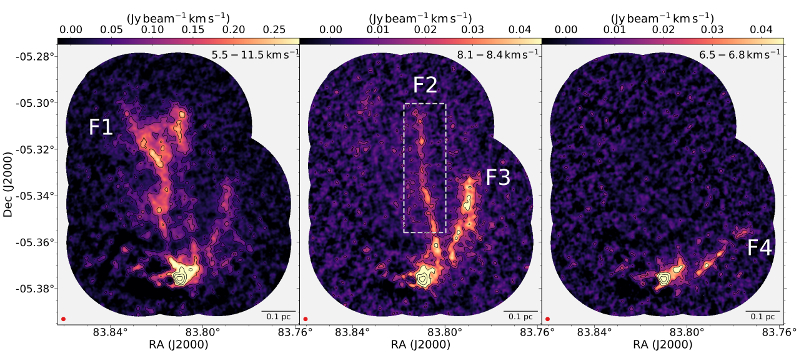| EPoS Contribution |
|
Dense Gas Kinematics and a Narrow Filament in the Orion A OMC1 Region Using NH3
Kristina Monsch USM-LMU, Munich, DE | |
| I will present combined observations of the NH3 (J,K) = (1,1) and (2,2) inversion transitions towards OMC1 in Orion A obtained by the VLA and GBT telescopes. With an angular resolution of 6" (0.01 pc), these observations reveal with unprecedented detail the complex filamentary structure extending north of the active Orion BN/KL region in a field covering ∼6'×7'. We found a 0.012 pc wide filament within OMC1, with an aspect ratio of ∼37:1, that was missed in previous studies. Its orientation is directly compared to the relative orientation of the magnetic field from the JCMT BISTRO survey in Orion A. We find a small deviation of ∼11 deg between the mean orientation of the filament and the magnetic field, suggesting that they are almost parallel to one another. The filament's column density is estimated to be 2-3 orders of magnitude larger than the filaments studied with Herschel and is possibly self-gravitating given the low values of turbulence found. We further produce maps of the gas kinematics by forward modelling the hyperfine structure of the NH3(J,K) = (1,1) and (2,2) lines. The resulting distribution of velocity dispersions peaks at ∼0.5 km/s, close to the subsonic regime of the gas. This value is about 0.2 km/s smaller than previously measured in single-dish observations of the same region, suggesting that higher angular and spectral resolution observations will identify even lower velocity dispersions that might reach the subsonic turbulence regime in dense gas filaments. | |
 | |
| Caption: NH3 (1, 1) integrated intensity maps of the combined data for different spectral ranges. | |
| Collaborators: J.E. Pineda, MPE, DE H. Liu, TW C. Zucker, Harvard, US H. Chen, Harvard, US K. Pattle, TW et al. |
Key publication
Suggested Session: Molecular Clouds |

